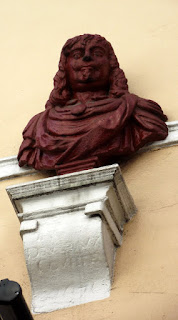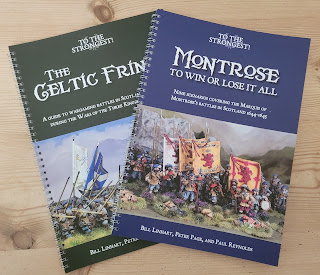Earl of Essex's Regiment of Foot
Robert Devereux, the 2nd Earl of Essex had been executed for leading a rebellion against Elizabeth I; the family was stripped of the title, but this would later be restored to the family by James I.
The 3rd Earl of Essex was friends with Henry Stuart, the Prince of Wales; which is a little surprising when we know that he was to go on and lead an army against the Crown.
Essex had an undistinguished military career between 1620 and 1624 where he served in Protestant armies in Europe. Notably, he commanded a regiment in the unsuccessful campaign to relieve the siege of Breda.
In 1638, he fought for Charles I during the First Bishops' War in 1639 as Lieutenant-General of the army in the North of England. As he wasn't given a command during the Second Bishops' War he threw his toys out of his pram and moved ever closer to the cause of Parliament.
Played by Charles Gray in the 1970 version of Cromwell, the film reinterprets something that was attributed to Essex to somebody else. Essex supposedly took a coffin and winding sheet to battle with him to Edgehill (it was carried in his coach); in the film the coffin belongs to Old Noll's preacher.
Also known as the Lord General’s Regiment of Foot and Old Robin's Foot, the Regiment was raised in 1642. They fought at Battle of Edgehill, the Standoff at Turnham Green, Siege of Reading, Battle of Caversham Bridge, First Newbury, Olney, Horsebridge, Lostwithiel, and Second Newbury.
In April 1645 they were disbanded and drafted into Sir Thomas Fairfax’s Regiment of Foot, and the last remaining 60 men of the regiment were then reduced into Major General Richard Browne’s Regiment of Foot.
The Regiment is re-enacted by Earl of Essex Regiment of Foot
Needless to say Old Robin's Foot, Peachey and Turton, Partizan Press is a goldmine of information. Recently reprinted with lots of extras, available from Caliver Books.
* If you would like to see a real object that is described as being watchet, have a look at the unknown flag held at the National Army Museum. Whilst not on display, a picture of it can be found here
Bust of Essex, high on the wall of The Devereux, Temple Bar, London
Essex had an undistinguished military career between 1620 and 1624 where he served in Protestant armies in Europe. Notably, he commanded a regiment in the unsuccessful campaign to relieve the siege of Breda.
In 1638, he fought for Charles I during the First Bishops' War in 1639 as Lieutenant-General of the army in the North of England. As he wasn't given a command during the Second Bishops' War he threw his toys out of his pram and moved ever closer to the cause of Parliament.
Played by Charles Gray in the 1970 version of Cromwell, the film reinterprets something that was attributed to Essex to somebody else. Essex supposedly took a coffin and winding sheet to battle with him to Edgehill (it was carried in his coach); in the film the coffin belongs to Old Noll's preacher.
Also known as the Lord General’s Regiment of Foot and Old Robin's Foot, the Regiment was raised in 1642. They fought at Battle of Edgehill, the Standoff at Turnham Green, Siege of Reading, Battle of Caversham Bridge, First Newbury, Olney, Horsebridge, Lostwithiel, and Second Newbury.
Essex's regiment wore orange tawney coats from September 1642 until re-clothed in an unknown colour in August 1643.
In November 1644 Essex's regiment received new flags to replace those lost in Cornwall, these were orange with white mullets (five-pointed stars).
At the First Battle of Newbury a set of orange colours with white eight-pointed stars was captured by the Royalists, that might have belonged to Essex's, but this is by no means definite.
Captain Saunderson's Company joined the Regiment in December 1642: they had previously been issued with watchet (greenish blue)* coloured coats and a flag of presumably different design to the rest of the Regiment - which could give a nice bit of variation for those thinking purely of the aesthetic of their army.
Regular readers (hello both of you) will be wondering if these fine fellows have appeared on the blog before? They have, they got a brief outing in the original Parliamentarian Foot post, back in the mists of time. In keeping with the spirit of how my units are recorded in the blog I thought it high time that they got their very own post. (Of course the now almost worldwide stay at home orders for Covid 19 mean I need something to keep the grey matter functioning.) A straight out of the bag unit here, painted by Alan Tuckey (that's why they look nice), but based by mine own clumsy hand.
Regular readers (hello both of you) will be wondering if these fine fellows have appeared on the blog before? They have, they got a brief outing in the original Parliamentarian Foot post, back in the mists of time. In keeping with the spirit of how my units are recorded in the blog I thought it high time that they got their very own post. (Of course the now almost worldwide stay at home orders for Covid 19 mean I need something to keep the grey matter functioning.) A straight out of the bag unit here, painted by Alan Tuckey (that's why they look nice), but based by mine own clumsy hand.
Needless to say Old Robin's Foot, Peachey and Turton, Partizan Press is a goldmine of information. Recently reprinted with lots of extras, available from Caliver Books.
* If you would like to see a real object that is described as being watchet, have a look at the unknown flag held at the National Army Museum. Whilst not on display, a picture of it can be found here
If you enjoyed reading this, or any of the other posts, please consider supporting the blog.
Thanks.















Comments
Post a Comment